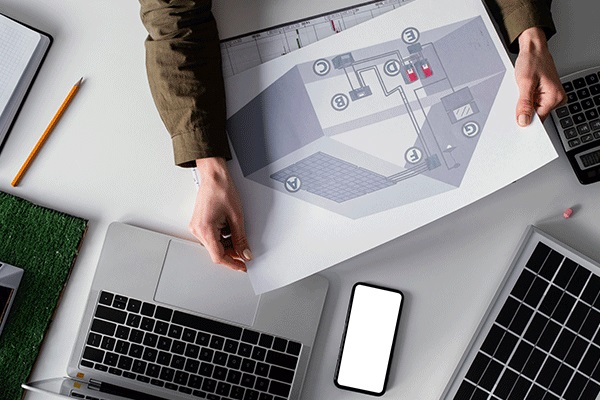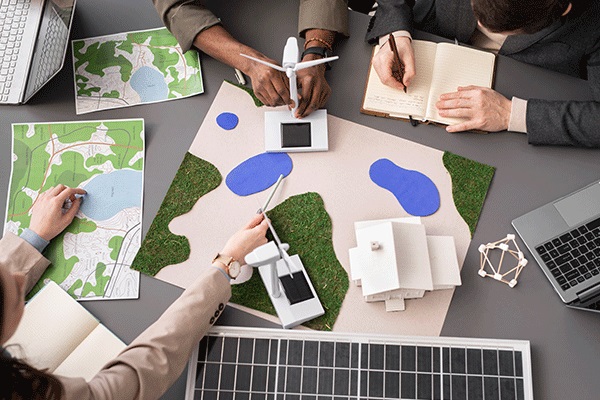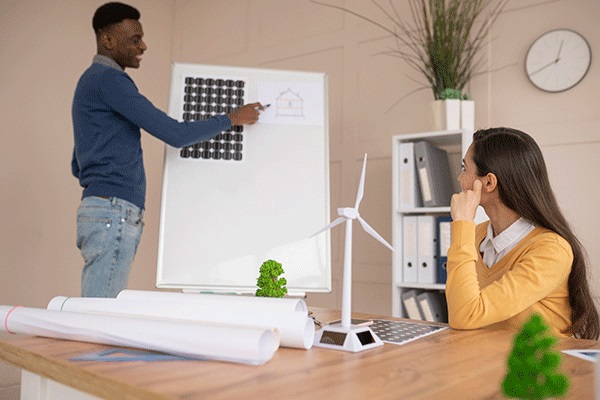Sustainability in construction is increasing due to regulatory pressure and inclinations toward green building adaptions with the help of sustainable MEP design solutions. There has been a strong notion that the installation of eco-friendly systems, the use of renewable resources, and smart technology have become crucial to reduce the impact of carbon footprint and other hazards on the environment.
Green building techniques: lower energy usage, water management, use of energy alternatives, building practices adhering to sustainability, and optimum maintenance process help in designing an MEP system that has a less adverse effect on the environment and improves cost-effectiveness and life-cycle. Being associated with the construction industry for over two decades now, eLogicTech advocates green building techniques for modern-day construction. With its experienced MEP team and BIM expertise, eLogicTech has been helping projects achieve sustainable MEP system design.
MEP and Sustainability
The implication of sustainability in building design is on the rise due to climate change awareness. According to the Environmental Protection Agency in the US, the energy use and consumption by the building sector are -39 percent of total energy usage, 12 percent of water consumption, 68 percent of total electricity consumption, and 38 percent of carbon dioxide emissions. Among the total electricity consumption- the HVAC system consumes 35 percent, lightning 11 percent, and appliances, such as water heaters, freezers, etc., consume around 18 percent.
These figures show the impact of the building and its MEP system on the environment, human health, and economy. The MEP system of a building plays a significant role in sustainability as it decides the working of the building structure and energy consumption.
Therefore, it becomes significant for efficient MEP planning and design to reduce the consumption of energy, water, and electricity and minimize the carbon footprint of the building.
Introduction to MEP Design Strategies for Green Building
MEP design services must integrate sustainable strategies in the plan for green building. The incorporation of sustainable design practices addresses each of the adverse impacts the MEP system has on the environment, making the building eco-friendlier and more cost-effective.

Lower Energy Usage
In commercial buildings, the lighting system and HVAC system alone consume 25% and 32% of the total energy consumption of the building. So, to reduce these numbers, MEP design services can take the following measures while designing the electrical and lighting systems of a building.
- For energy efficient requirements, adherence to national and state building codes for the building’s shell, roof, floor, walls, and windows helps minimize the energy requirements.
- The application of lighting fixtures with motion sensors aids in smart energy utilization. Sensors turn the lights on when people walk into the space and automatically switch off when they walk off. We can also use eco-friendly light fixtures and bulbs.
- HVAC system with AI technology automates processes supporting energy efficiency and waste reduction.
- IoT devices help predict the outside temperature and monitor and adjust the indoor temperature accordingly. The measurement of heat levels and floor temperature helps track human activity.
- The ventilation system considers the natural environment and uses heating processes that reduce heat loss and provide required airflow.
Energy Modeling
Energy Modeling is a series of calculations generated by a computer that gives information on the anticipated energy consumption of your project. It simulates how much energy is going to be consumed and it’s used to help designers make smarter decisions and also help the owners a sense of how much the energy bill is going to cost, giving a glimpse into the future of your building. The core value of using Energy Modeling software is as a verification document to meet energy performance requirement codes from the city or certification programs like LEED.
Building and Construction sectors are responsible for over a 1/3 of global energy consumption and almost 40% of the total and non-total global CO2 emissions. Sadly, this figure is increasing. As an Architect, you have the skillset and opportunity to make an impact.
Architecture and engineering experts have recognized energy modeling as “the most powerful design-assist tool available to a project team”. A well-prepared energy model will account for the following factors:
- Building mass, shape, and orientation
- Neighborhood effects of surrounding buildings
- Building structure
- Enclosure and facade performance
- Mechanical and HVAC loads
- Electrical loads and lighting intensity
- Future climate loads.
Energy modeling software like Comcheck, eQuest, and energyPRO, when inputted correctly, the benefits delivered can be invaluable for building owners, designers, and occupants alike. Projections can play a significant role in determining Energy Conservation Measures (ECMs), leading to reduced operating and maintenance costs over the life cycle of the building. They also lead to improved occupant thermal comfort and a lowered carbon footprint. In new buildings, design-assist iterations can help the design team determine the most suitable form of the building, and the impact of design choices on energy efficiency.
Water Management
Depending on its location and climate, a residential building consumes around 33% of energy for heating water, resulting in greenhouse gas emissions. A green-house efficient water system helps in reducing 80% of gas emissions. A few other strategies for efficient water management are
- We can use a solar hot water system, an electric heat pump hot water system, or a gas hot water system. An AAA-rated shower produces 9 liters of water per minute, helping in the reduction of water and energy wastage.
- A low-flow fixtures faucet uses 40% less water than standard faucets, and a low-flow toilet saves 2.2 gallons of water per flush.
- The installation of greywater systems- filters kitchen wastewater and is further used for toilet flushing or irrigation purposes.
- A smart plumbing system reduces control and treats stormwater runoff from a building.
- We should plan and implement rainwater harvesting design in a building for water conservation and optimum utilization.
Energy Alternatives
BIM technology helps find top energy consumers inside a building. It helps identify HVAC inefficiencies, top electricity users, peak energy consumption hours, etc., as environmental data gets automatically collected and reflected in a built 3D model.
The BIM process helps explore energy alternatives such as
- Wind, solar, and geothermal sources help reduce carbon footprints.
- Ensure solar panels receive enough daylight and help install solar collectors with boilers and thermostats for solar panel efficiency.
- Check the right amount of wind gets access through wind turbines.
- Implement daylight harvesting, geothermal heating, and cooling systems.
- BIM helps plan the size of spatial requirements for alternative energy equipment by coordinating between power and special systems.
Sustainable Materials and Building Practices
For an MEP design with optimum energy efficiency, an architectural design should consider direction, wind, and weather factors. Therefore, site selection is crucial for taking natural advantages. We need to follow some sustainable building practices and materials.
- We should use recycled materials for buildings and interiors. And select equipment and materials of the requisite size and material.
- The use of double-glazed windows helps insulation, and the roof vent naturally escapes hot air.
- The light-colored roofs reflect heat and reduce the load on air conditioners.
- Window shading protects interiors from heat, reducing the load on air conditioners.
- Building orientation and landscaping help minimize the effect on local ecosystems. For example, a building placement near the road and room orientation away or towards the summer sun based on the climate saves load on the HVAC system and cost.
Optimization of Operational and Maintenance Practices
A robust MEP system reduces operational and maintenance costs in the long run. These maintenance and operational measures can help optimize the process.
- We should design MEP systems with materials, equipment, and components requiring less water, energy, and toxic chemicals & cleaner for maintenance.
- We can customize the MEP system for maximum efficiency, and passive design elements and sustainable materials require lower maintenance costs.
- Installation of meters helps track sustainability progress and reduce life cycle costs.
Technology Facilitating Sustainable MEP Design

The technology integration in MEP system design offers a cost-efficient solution and reduces cost.
Efficient heating system
An efficient heating system can maximize the use of natural resources.
It reduces heat loss and maintains adequate airflow throughout indoor spaces. The system also uses heat from machines and human activities.
Solar Energy Collectors
The solar energy collector’s integration with thermostats and boilers helps consume renewable energy resources.
Sensor System
The sensor system automates the data collection and analysis process, giving a real-time operational overview of the building service. It also helps regulate and monitor energy consumption by HVAC and other devices. It provides information related to ongoing trends and insights for avoiding disruptions and improvement.
Smart Air conditioning
Smart air conditioners adjust indoor temperatures respective to outdoor weather and climate. Sensors detect room occupancy, change temperatures according to outside weather, and turn off the AC in case of no occupancy.
Incorporate Sustainable MEP Design Solutions for Green Building

Leveraging BIM technology, advanced AI enables sensor systems, sustainable material use, sustainable building practices, and other advanced technology integration to help achieve sustainable MEP design solutions. eLogicTech, a construction, engineering, and architectural service provider, offers MEP services and sustainable MEP design solutions. Our expertise in BIM services helps achieve optimum MEP design solutions for sustainability.
eLogicTech Solutions is well known for its impeccable capabilities of providing state-of-the-art MEP modeling services across the US and Canada region. With active involvement in the industry and construction requirements, eLogicTech also aims to provide MEP energy PRO, eQuest, and COMcheck support services for sustainability design and calculation support for building projects.
Our in-house MEP experts assist in providing sustainable MEP modeling solutions for all your building projects by preparing the energy model from the concept to evaluate efficient energy consumption and achieve environmental well-being.







